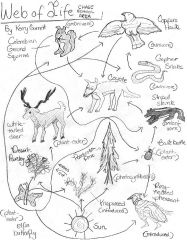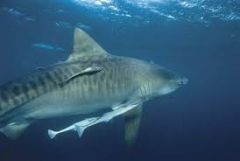![]()
![]()
![]()
Use LEFT and RIGHT arrow keys to navigate between flashcards;
Use UP and DOWN arrow keys to flip the card;
H to show hint;
A reads text to speech;
25 Cards in this Set
- Front
- Back
|
The Web of Life
|

|
|
|
Star-Stuff
|
All life is composed of the same stuff, star-stuff to be exact. Carbon, nitrogen, oxygen, and other elements common to all lifeforms were forged within stellar furnaces and disgorged in supernova explosions.
|
|
|
Prokaryotes
|
All of Earth's diverse inhabitants descended from single-celled, aquatic bacteria. Starfish, Dinosaurs, mushrooms, petunias and humans alike trace their origins to the humble Prokaryote bacterium.
|
|
|
Age of Bacteria
|
Single-celled prokaryotes appeared virtually as soon as the planet had cooled enough to sustain water, suggesting that some life may not have been a lottery-like stroke of luck but like a virtual inevitability.
|
|
|
Five Kingdoms
|
Bacteria
Protists Fungi Plants Animals |
|
|
Bacteria
|
Microscopic, single-celled organisms that gave rise to all other life forms.
|
|
|
Protists
|
Slimy, nucleated organisms that include algae, amebas, water molds, and slime molds.
|
|
|
Fungi
|
A highly successful and diverse group that includes yeasts, mushrooms, and various molds, all of which grow form spores.
|
|
|
Plants
|
The diversity of plants develops either form spores or from sexually reproduced embryos.
|
|
|
Animals
|
Grow from embryos that result from union of sperm and egg.
|
|
|
Symbiosis
|

When two kinds organisms live together in close physical contact benefiting one another.
|
|
|
Eukaryotes
|
The first protists were eukaryotes, bacteria with nuclei. The protists diversified into a variety of groups which gave rise to fungi.
|
|
|
First Animals
|
Evolved from protists at the close of the Precambrian, about 650 million years ago. The Phanerozoic then opened with a gang, called the cambrian explosion about 540 million years ago.
|
|
|
Vertebrates
|
These organisms in the Cambrian explosion then gained a complex head - including a subdivided brain, eyes, ears - as well as a stiffened cord running down the spinal column.
|
|
|
Small Jawless Fish
|
525 million years ago. These fish grew bony armor within the skin. Gills were modified to form jaws resulting in a series of highly successful jawed fishes.
|
|
|
Moving to the Land
|
By the Late Devonian, about 360 million years ago, one group of fishes with muscular fins mad a fundamental shift by moving to the and and facing the effects of gravity for the first time. These four-footed animals were the first Tetrapods.
|
|
|
Amphibians
|
The dinosaur lineage took on the form of amphibians for a long period of deep time, with sprawled limbs and newly modified ears adapted for hearing in air.
|
|
|
Amniote Egg
|
325 million years ago, this egg with a semipermiable shell allowed reproduction to occur away from standing water.
|
|
|
Small Bodied Reptiles
|
These new small-bodied reptiles from the same lineage with an amniote egg could now spread across the land and begin the road of evolution to becoming dinosaurs.
|
|
|
Archosaurs
|
One group of reptiles that evolved to larger body sizes. The common ancestor of pterosaurs and dinosaurs was the small, agile, lightly built, carnivorous , bipedal archosaur.
|
|
|
Permian Extinction Event
|
The Paleozoic-Mesozoic boundary was marked by the greatest extinction in the history of life. The Permian extinction event drove 90% of the Earth's species to extinction.
|
|
|
First Dinosaurs
|
The first dinosaurs appeared 230 million years ago. Dinosaurs remained the dominant large animals on land for the next 150 million years. Characters of the first dinosaurs include: upright posture, open hip socket, and an opposable thumb for grasping.
|
|
|
Quadrupedalism
|
Walking on all fours. Re-evoloved multiple times within plant-eating dinosaurs.
Stegosaurus, sauropods, and ceratopsians. |
|
|
Bipedalism
|
Walking on two legs. With opposable thumbs, resulted in forelimbs free for a number of functions.
|
|
|
Giant Asteroid
|
65 million years ago, a giant asteroid slammed into the planet, killing off most of the dinosaurs, as well as many other lifeforms form land and sea. One group of dinosaurs, the birds, managed to survive, remaining successful to the present day.
|

